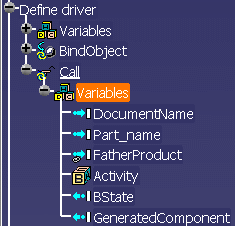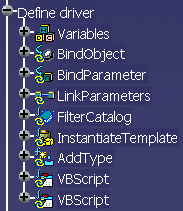 |
-
From the Start>Knowledgeware menu, access the
Business Process Knowledge Template workbench.
-
Open the
BktBehaviorCallLibrary1.CATfct file. This file contains the sequence
that you are going to re-use.
-
In the Behaviors tab, click the DefineComponent sequence
and click the Expose Main Behavior icon ( ).
The icon associated to the DefineComponent sequence turns to green ( ).
The icon associated to the DefineComponent sequence turns to green ( )
indicating that the sequence is now exposed in the Knowledge Dictionary.
If the sequence is not correctly exposed, the icon turns to red ( )
indicating that the sequence is now exposed in the Knowledge Dictionary.
If the sequence is not correctly exposed, the icon turns to red ( ).
For more information about this dictionary, see Infrastructure
User's Guide: Advanced Tasks: Managing Knowledgeware Resources. ).
For more information about this dictionary, see Infrastructure
User's Guide: Advanced Tasks: Managing Knowledgeware Resources.
-
Open the
BktUseCall.CATfct file. In the Behaviors View, double-click the
IndirectVision behaviors node to open the Behaviors tab.
-
In the Behaviors tab, expand the IndirectVision and the
Define driver nodes. The Define driver sequence already contains a
BindObject behavior that will enable you to access the root Product when
working in the generated workbench.
-
Click the Define driver sequence and click the Call
behavior icon ( )
in the Infrastructure toolbar. The Call behavior is created. )
in the Infrastructure toolbar. The Call behavior is created.
-
Double-click it to open the Call behavior window, then
select the sequence that you want to re-use and map the attributes:
 |
The browser lists the
sequences exposed in the session and the ones exposed and
referenced in the Knowledgeware index file. |
|
|
|
|
|
-
Expand the BindObject and the Call behavior nodes,
right-click the FatherProduct input parameter located below the Call
behavior node, select FatherProduct object>Link and click the
Link output parameter located below the BindObject node.
 |
 |
 |
| The picture above shows the Define driver sequence
containing the Call behavior. |
The picture above shows the Define driver sequence
and the behaviors that you would have used if you had not used the
Call behavior. |
-
Valuate the Part_name variable. To do so, double-click it
and enter a name in the dialog box. Click OK when done.
-
Save your file.
-
Click the Generate Applicative Workbench icon
( )
to generate a user workbench. Enter the name of the workbench,
Insert_Driver in this example, and select the workbench type (Product
here). )
to generate a user workbench. Enter the name of the workbench,
Insert_Driver in this example, and select the workbench type (Product
here).
-
From the Tools>Options>Knowledgeware>Business
Knowledge Template menu, select All Users from the
Access Rights scrolling list and click OK to work in a
User environment.
-
In the User Workbench, select Product1 in the
specification tree and select the IndirectVision check box to type the
root product. Its name is now IndirectVision:Product1.
-
Right-click IndirectVision:Product1(Product1) and select
IndirectVision (Product1) object>Define vehicle data.
-
Select the
BktVehicleData.CATPart file and click Open. The vehicle is
inserted.
-
Right-click the IndirectVision (Product1) object in the
tree and select IndirectVision (Product1) object>Define driver.
-
Select the
BktDriver2D95Male.CATPart file and click Open. The driver
is inserted.
|
![]()